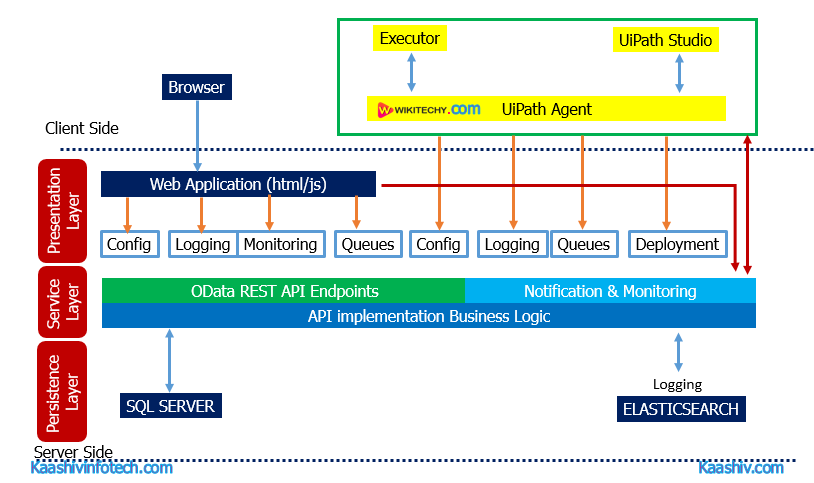UiPath Architecture
UiPath Architecture
The architecture contain three UiPath components - UiPath Studio, UiPath Orchestrator, and UiPath Robot, with the database servers and browser.
- UiPath Studio may be a GUI based dashboard used for creating automation workflow for the tasks to be automated.
- The software robots or bots are used to execute the automated steps or activities as specified.
- Orchestrator is that the medium that acts because the interface between UiPath Studio and software robots. It helps to manage the automation tasks

UiPath Architecture
The architecture can be classified within the following two parts:
- Client-side and server-side detailing.
- Three Layered detailing.
Client-side and Server Side Detailing
- Client-side includes components of UiPath which will be directly accessed by the user or developer. It generally includes UiPath Studio, Robot, Browser, and UiPath Agent.
- Server-side includes the backend tasks of UiPath. When a user creates activities or workflows, they're stored within the databases.
- UiPath orchestrator selects the appropriate functions and the software robots to perform the required tasks as per the code.
- The logs and stats of the robots are a part of the backend. Logs are helpful for analyzing the performance of robots and find errors.
Read Also
Three Layered Detailing
The architecture of UiPath are often explained by classifying the components into the following three layers:
Client Layer
- The client layer consists of these components of UiPath that are assessable to the users. For instance, UiPath Studio, Robots, Browsers, UiPath agent, and executors. By these components, a user or a developer can design and develop various tasks to be automated. These tasks are often executed with the help of software robots. This layer is also known as the presentation layer.
- The UiPath robot contains the subsequent two components:
- UiPath Agent Service:
- In UiPath, this service acts because the mediator between the client-side and therefore the server-side of UiPath. All the details and knowledge are communicated over the agent. Also, the messages are logged into the Orchestrator then transferred to the SQL server. The service can be used to check all the available tasks within the system tray. Additionally, it can modify system settings and permit existing tasks to start/stop.
- UiPath Executor Service:
- This service is employed by software robots to execute the specified tasks under a Windows session.
Server Layer
- The most important layer of UiPath architecture. All server details are displayed within the server layer. The server layer mainly includes the UiPath Orchestrator. When the robots are completely developed to execute the tasks, the whole project is often uploaded on the server. The project is often executed on multiple systems with the help of an Orchestrator.
- The Orchestrator controls the whole project. It monitors project activities, schedules software robots for execution, and generates summarized reports supported filtered requirements. It helps to orchestrate software robots to continue executing repetitive tasks. With its web-based management system, it helps our project to satisfy project requirement, service levels and timelines.
Persistency Layer
- This layer mainly consists of database servers. All the configuration details of the robots are stored during this layer. The configuration details include different user's data, their respective robots, assigned tasks, logging information, and asset details, etc. of these details are entered by the users within the Orchestrator.
- Besides, the persistency layer is additionally responsible to stay the log details updated by the UiPath agent services. These logs are stored in elastic search. The logs are mainly helpful for finding errors and rectify them.
- The process-level data is usually stored within the relational database management systems like SQL Server. This makes checking out logs easier from the huge quantity of data.
- The persistency layer also takes care of queues and therefore the tasks in queues.
